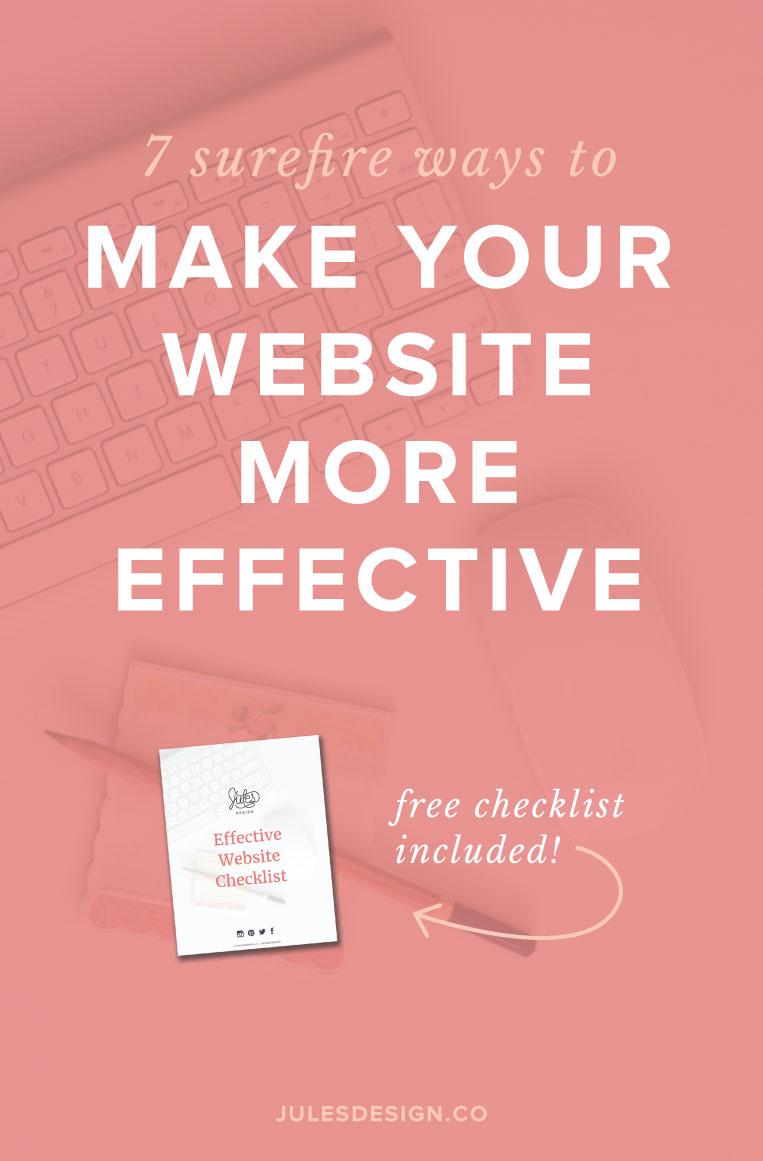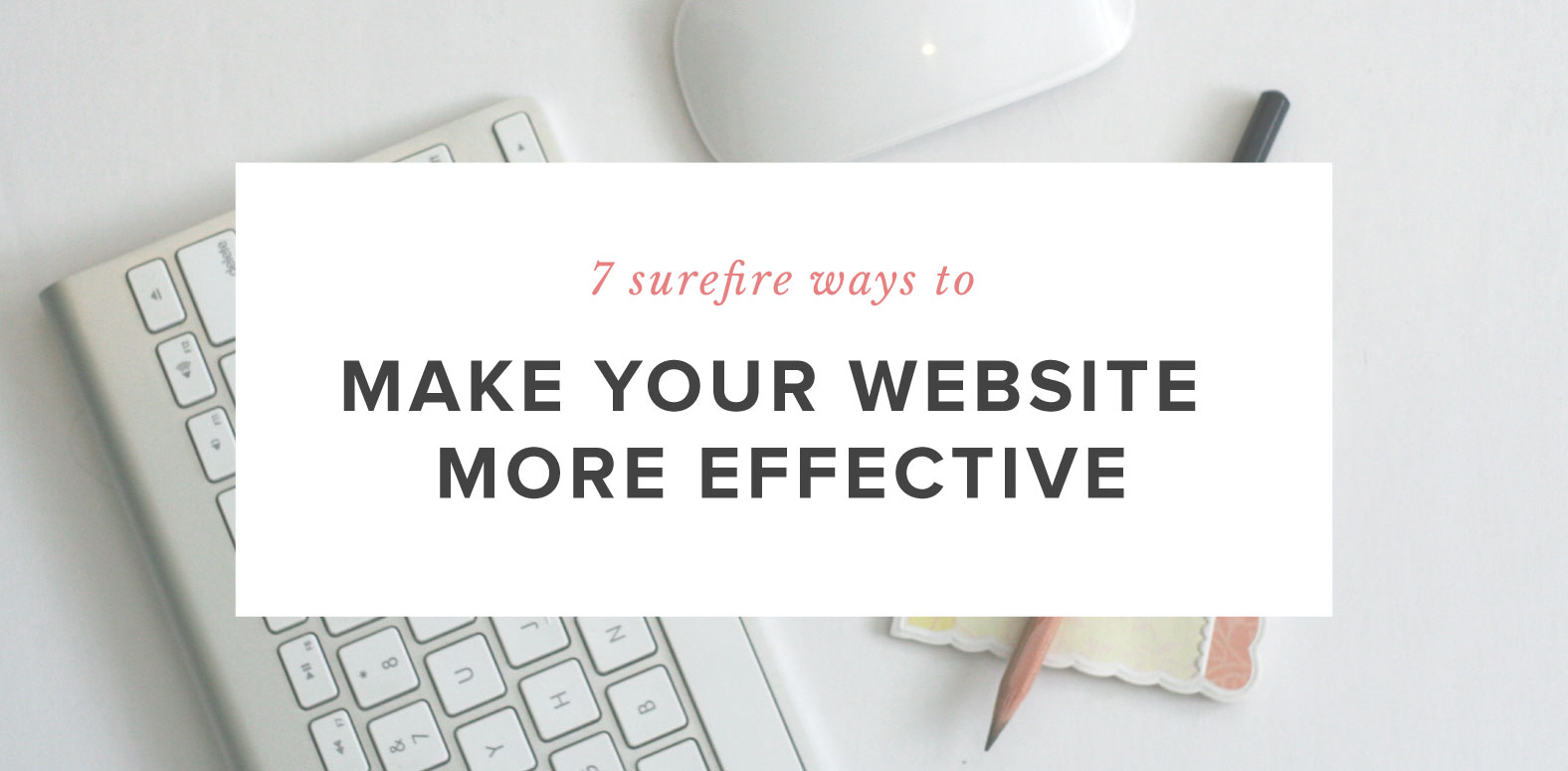Believe me, I know that building a website is a lot of hard work. Once you start designing, it can be tricky to choose what to focus on doing first. Or, maybe, you already have a website but are looking for ways to make it more effective so that it reaches the right people.
Today, I’m sharing 7 of my best website design tips with you! I hope that you find these helpful and that you implement them on your own website. Since this post contains so much information, I compiled all of the action steps into a checklist that you can reference at any time! You can download that at the bottom of this article and refer back to over and over again.
This content was originally a series over on Instagram Stories. But, I’m publishing it here so that it has a permanent home that you can revisit at any time. I’m always sharing lots of tips & tricks over on Instagram so make sure to follow me if you aren’t already.

Site Navigation
Streamlining your website’s main navigation is one of the easiest things that you can do to improve your site. And, it makes such a big impact! If you have two many options on where to go, those viewing your site might get confused or overwhelmed by all of the information.
To simplify the sitemap of your website – Remove excess pages that aren’t important or combine smaller pages together. Don’t forget about mobile devices, having a website that scrolls with more information on it, is much more effective than having little bits of information spread out on separate pages.
Also, try to reduce sub-navigation as much as possible. And definitely, try to avoid sub-sub navigations. These are the little drop-down menus that appear when you hover over a page in your main menu. The more complicated you make things for the person viewing your site the harder it will be for them to use.
Make sure that your navigation is clear and to the point so that the person viewing your website instantly knows where each navigation item will take them. It’s also totally fine to create secondary menus (possibly in the footer or sidebar of your website) to include information that needs to be on your site but doesn’t need to be in the main menu…such as a privacy policy or terms and conditions.
Captivating Photography + Graphics
Next, let’s talk all about why the visuals on your website are so important. Having captivating photography and relevant graphics is key to visually representing what your business is all about.
Most people who visit your website will look at the visuals on the page first, then your headlines and then finally your body copy. This is why it’s so important that your visuals are on point! They can’t just look pretty. They need to fit into the copy that is around them and make the person viewing your website want to learn more.
Your images should also, of course, fit into your brand identity. For instance, if your brand has a lot of bright colors in it, it’s not going to look right if you have dark, moody images. Your imagery and graphics should be consistent with your brand identity.
Don’t be afraid to use stock images if you need some help with visuals. There are lots of fantastic stock imagery sites out there that are perfect for digital entrepreneurs. If you’re looking some free options check out Pexels and Pixabay. I also love Creative Market for inexpensive stock imagery.
So, take a look at your current imagery and graphics and make sure that they are on brand, are relevant and that they are placed strategically around your website.
Call to Action
So when you hear the word call to action in reference to a website you might be thinking of cheesy things like “click here” or “buy now”. But, in reality, calls to action should really go way beyond the obvious. They are a great way to guide people around your website in a strategic way.
Think of Calls to Action, as little breadcrumbs that are sprinkled throughout your website. Each time a person sees one they will pick it up and follow it to the next crumb. Leading them throughout your website in the way that you think is best.
So, for instance, on your homepage, you might want to have a call to action for a person to learn more about your services and then on the services page have another call to action that drives them to contact you. You can always play around with different calls to action and see what performs best on your site by installing heat maps.
Now that you have a better idea of what a call to action is and why it’s so important, take a look at your site and see if you have any calls to action or if you’re really leaving it up to the viewer to navigate your website on their own. If you find that your missing those calls to action, then go ahead and add them!
What You Do
Does your homepage include a brief description of what you do? It should. It’s so important to quickly state what you offer on your homepage so that anyone who visits your site knows instantly, what you do and if they’re in the right place or not.
This should be one of the first things that people see when they visit your homepage. So, try to place it above the fold – meaning before someone scrolls down – on your website. You should elaborate on what you do or offer on other pages throughout your site too, such as the services or portfolio page.
If you’re having trouble figuring out what to say here try to think of this as your elevator pitch. It should only be about 1-2 sentences long and should explain what you do in a way that makes clients want to learn more. Ask yourself:
• What are the benefits of working with me?
• What problems do I solve for my clients?
• What makes my services unique from others in my industry?
Go ahead and start there and then develop a couple of sentences that describe your offering or service so that people know what you do as soon as they get to your website.
Testimonials
Client testimonials are an excellent way to build credibility as a business owner and gives potential clients a little insight into what it would be like to work with you. Instead of just having a separate testimonials page, try to incorporate a couple testimonials throughout your website.
The main reason that I suggest doing it this way is that users might not click on your testimonials page, and then, they would be missing out on all of the awesome feedback that you have. Try putting a couple of relevant testimonials on your homepage, services page, and portfolio pages so that wherever someone goes they will see the amazing feedback that you have gotten from your previous clients!
If your business is brand new and you don’t have any testimonials then put a plan into place so that you can ask future clients for testimonials when a project is over. Try to get testimonials that show how your offering or service helped your client to reach their business goals. Create a questionnaire that asks specific questions about the value that you provided to ensure that you get quality testimonials.
About Page
The about page is probably one of the most frequently viewed pages on your website but is also usually one of the most neglected pages.
It’s likely that a person clicking on this page is visiting your website for the first time and they are intrigued to learn more about you. Which, is why it’s so important that the page explains who you are and also how you can help.
Try to step into the shoes of your client and think about what kinds of problems they might be having. Reiterate what those issues are and how you are able to solve them with your services. The about page needs to be more about how you can help others and less about what your credentials are.
That being said, it’s still important to connect with your audience and show them what you’re all about. Include a photo of yourself so that people can put a face to your brand. It also helps to tell everyone viewing the page a little bit more about you. So try to get a little more personal here and mention things that you like to do in your free time. No need to go overboard but include a few things that people viewing your website might also relate too.
Email Optin
Finally, you’ll want to include some kind of email capture on your website. This is essential so that you can start building a list for your business and marketing yourself via email. I’m going to cover what a good email opt-in looks like and what a bad one looks like.
So let’s start with you shouldn’t do. And, that’s to have a soft ask like “join my newsletter” or “join my email list for the latest blog posts.” It’s not that this sounds bad, but it’s not going to get you the result that you want, which, is for people to join your list.
What you should have is an email opt-in that provides some free content in exchange for a person’s email address. This could be a free worksheet, checklist or even a free email course. You can create anything that you want, as long as it relates to your expertise and is something that will actually provide value to your target audience.
So, the reason that this works is that you’re providing some information in exchange for a person’s email address. People are less likely to give you their email address if they don’t get something of value in return. Think about it, why did you opt-in to the last email list that you joined? They were probably offering a free download or discount which made you want to join.
Watch the Simplify to Sell Website Workshop
I’ll show you how to streamline, connect with your niche, and earn more money from your website during this free on-demand website workshop for health and wellness professionals.
You only get one homepage. Let’s make it work harder. Get a free expert review of your homepage, so it actually attracts your dream clients!
Free Homepage Health Check
Copyright 2022 - All Rights Reserved | Website made by Jules Design (of course!)
Terms & Conditions
Privacy Policy
We are a Richmond Virginia based website design and brand identity design studio for dietitians, nutritionists, health coaches, fitness professionals and wellness entrepreneurs. We love working with brands with compassion in the health space.
